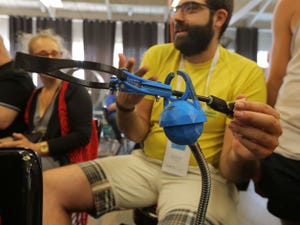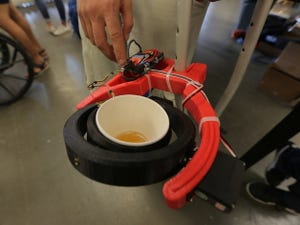What Crowdsourcing Can Do to Help the Disabled
September 30, 2015
Some of the most promising technologies developed at a recent Google.org-supported makeathon have been uploaded to MakerBot's Thingiverse, inviting tinkerers from around the world to improve and customize the plans.
Brian Buntz
Google's philanthropic arm recently helped sponsor the Bay Area Makeathon in San Francisco that gave participants 72 hours to shift the lives of the disabled.
Now, the 3-D printing firm MakerBot, which provided 3-D printers for the event, has announced that digital plans for some of the most promising technologies developed at the event have been posted to its Thingiverse platform.
Makerbot is sponsoring an Assistive Technology Challenge to develop further iterations of hardware and software prototypes to help meet the needs of people with disabilities. "Use their work as inspiration to design something great for a fellow human," the Makerbot website encourages.
"This challenge makes the life-changing inventions from the Bay Area Makeathon available to people with disabilities worldwide and is inviting the global Thingiverse community to further iterate on the designs and prototypes," says Johan-Till Broer, public relations manager at MakerBot,
The Thingiverse files are available for any users in the world to download, and potentially modify under the Creative Commons license.
Some of the examples of the most promising technologies developed at the Makeathon, which was organized by Tikkun Olam Makers (TOM) and the United Cerebral Partners of the North Bay, include those below:
Grabber

The winner of the MakerBot Award for Rapid Prototyping at the Bay Area Makeathon, Team Grabber created a grasping device to enable Kim Lathrop, who was born with no arms, to move and hold onto objects via a device placed in her mouth. "At home, I use mouth sticks to hit light switches and to push buttons on the remote control and telephones and stuff like that. I also have a longer one for bringing things closer to me," Kim Lathrop recounted. But I have never had one that grabbed things to help me pick up a plate or to move a telephone to move it to another table." In a press release, Lathrop said the device will enable her to do things like set a table for guests.
Team members: Alex Gecht, Inbal Halperin, Kim Lathrop, Maayan Kahana, and Noam Platt.
Carry Crutches
 The Team Carry Crutches pondered how to help people who use crutches carry things. Carrying a cup while walking with crutches can seem nearly impossible, so the team developed a self-stabilizing cup holder that can be affixed to a crutch. A mechanical version was designed to be low cost--the materials are only $15. An electronic version costs twice as much, but offers more stability.
The Team Carry Crutches pondered how to help people who use crutches carry things. Carrying a cup while walking with crutches can seem nearly impossible, so the team developed a self-stabilizing cup holder that can be affixed to a crutch. A mechanical version was designed to be low cost--the materials are only $15. An electronic version costs twice as much, but offers more stability.
Team members: Benoy Bhagattjee, Daisy Bermudez, Ilan Sherman, Maayan Dremer, Matthew Wasala, and Tomas Garces.
Smart Seat

People who use wheelchairs extensively can develop pressure sores from being fixed in the same position. To combat the problem, a team took on the name "Smart Ass" to develop a 3-D printed device that can instruct a user to shift their position. Equipped with sensors, the device can also be controlled using a smartphone app.
Team members: Hagit Alon, Oscar Segovia, Paul Herzlich, Pierre Karashchuk, Shaun Giudici, Tomás Vega, Yakshu Madaan, and Yonni Bank.
iEat: Independent Feeder
People who have limited control of their hand can have significant trouble feeding themselves as using a spoon, fork, or knife can require significant dexterity. While feeding devices are available, they are often expensive and limited in their functionality. Team iEat has developed a low-cost device that enables people with limited hand control to feed themselves.
Team members: Clarice Torrey, Dana Yichye-Shwachamn, Ken Fujimoto, Randy Darden, and Zebreda Dunham.
Learn more about cutting-edge medical devices at MD&M Philadelphia, October 7-8, 2015. |
Brian Buntz is the editor-in-chief of Qmed. Follow him on Twitter at @brian_buntz.
Like what you're reading? Subscribe to our daily e-newsletter.
About the Author(s)
You May Also Like


